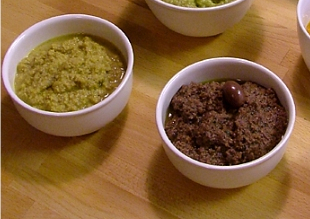Tapenade
Tapenade is a savory paste traditionally made from olives, capers, anchovies, and olive oil. It is a popular appetizer in the Mediterranean cuisine, particularly associated with the Provence region of France. Tapenade is often served as a spread on bread, crackers, or vegetables, and can also be used as a condiment or ingredient in various dishes.
History
The origins of tapenade can be traced back to ancient times, with variations of olive-based pastes found in several Mediterranean cultures. The name "tapenade" comes from the Provençal word tapeno, meaning caper. The recipe was formalized in the late 19th century in Marseille, France, by chef Meynier, who combined olives, capers, anchovies, and olive oil into a paste that has since become a staple of Provençal cuisine.
Ingredients
The primary ingredients of tapenade are:
- Olives - Typically black olives are used, but variations with green olives also exist.
- Capers - Small, pickled flower buds that add a distinctive tangy flavor.
- Anchovies - Salt-cured fish that provide a salty, umami depth to the paste.
- Olive oil - Used to bind the ingredients together into a spreadable paste.
Additional ingredients may include garlic, lemon juice, herbs such as thyme or rosemary, and pepper.
Preparation
To prepare tapenade, the olives, capers, and anchovies are finely chopped or blended together. Olive oil is then gradually mixed in until the desired consistency is achieved. The paste can be made to be chunky or smooth, depending on personal preference. Garlic, lemon juice, and herbs can be added for extra flavor.
Serving Suggestions
Tapenade can be served in a variety of ways:
- As a spread on toasted baguette slices, crackers, or crostini.
- As a dip for raw or blanched vegetables.
- As a filling or topping for fish, chicken, or vegetables.
- Mixed into pasta or used as a condiment for sandwiches.
Variations
While the traditional tapenade is made with black olives, capers, anchovies, and olive oil, there are numerous variations that include:
- Green olive tapenade, which uses green olives for a slightly different flavor profile.
- Artichoke tapenade, which includes artichoke hearts for a milder taste.
- Sun-dried tomato tapenade, which incorporates sun-dried tomatoes for a sweet and tangy flavor.
Cultural Significance
Tapenade is more than just a food item in the Mediterranean; it represents the rich culinary traditions of the region. It is a common feature in Provence and throughout the Mediterranean, where olives and olive oil play a central role in the diet.
Transform your life with W8MD's budget GLP-1 injections from $125.
W8MD offers a medical weight loss program to lose weight in Philadelphia. Our physician-supervised medical weight loss provides:
- Most insurances accepted or discounted self-pay rates. We will obtain insurance prior authorizations if needed.
- Generic GLP1 weight loss injections from $125 for the starting dose.
- Also offer prescription weight loss medications including Phentermine, Qsymia, Diethylpropion, Contrave etc.
NYC weight loss doctor appointments
Start your NYC weight loss journey today at our NYC medical weight loss and Philadelphia medical weight loss clinics.
- Call 718-946-5500 to lose weight in NYC or for medical weight loss in Philadelphia 215-676-2334.
- Tags:NYC medical weight loss, Philadelphia lose weight Zepbound NYC, Budget GLP1 weight loss injections, Wegovy Philadelphia, Wegovy NYC, Philadelphia medical weight loss, Brookly weight loss and Wegovy NYC
|
WikiMD's Wellness Encyclopedia |
| Let Food Be Thy Medicine Medicine Thy Food - Hippocrates |
Medical Disclaimer: WikiMD is not a substitute for professional medical advice. The information on WikiMD is provided as an information resource only, may be incorrect, outdated or misleading, and is not to be used or relied on for any diagnostic or treatment purposes. Please consult your health care provider before making any healthcare decisions or for guidance about a specific medical condition. WikiMD expressly disclaims responsibility, and shall have no liability, for any damages, loss, injury, or liability whatsoever suffered as a result of your reliance on the information contained in this site. By visiting this site you agree to the foregoing terms and conditions, which may from time to time be changed or supplemented by WikiMD. If you do not agree to the foregoing terms and conditions, you should not enter or use this site. See full disclaimer.
Credits:Most images are courtesy of Wikimedia commons, and templates, categories Wikipedia, licensed under CC BY SA or similar.
Contributors: Prab R. Tumpati, MD

